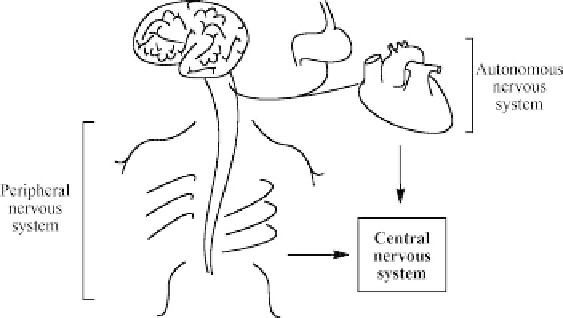Biomedical Engineering Reference
In-Depth Information
d
n
4
t
3
n
g
|
0
Figure 2.3
Schematic of the nervous sytem.
areas of scientific endeavor.
11
Research conducted in the field ranges all the way
from the cellular biology of nerve cells to imaging and brain function. It is
considered to be divided into a number of areas which include neuro-
physiology, cognitive science, and computational, molecular, endocrinological
and engineering neuroscience.
12-16
At the heart of these activities is the study of
the structure and function of single nerve cells or of the massive collections of
neurons in the nervous system.
The human central nervous system (CNS) is composed of three anatomical
units which are designed to act in a unified fashion (Figure 2.3). These are the
brain and spinal cord, peripheral nervous system and the autonomous nervous
system. (For the non-biologist, the structure and functions of the brain are
described beautifully in the superb, illustrated text by Rita Carter.
17
) The
second of these systems permeates the whole body and consists of a very
complex network of nerves that emanate from both cranial and spinal nerves.
Information both passes to and from the brain in this system, which incor-
porates an astonishing range of hierarchical levels ranging across the brain,
networks, neurons and, of course, molecular chemistry. We turn to a concise
look at the latter two of these components in more detail, since much of the
application of devices in neuroscience is connected to this area.
n
3
.
2.4.1 Anatomy and Types
The neuron is an electrically excitable cell that conveys information through
chemical and electrical signaling mechanisms. The cells are incorporated into
complex networks which display massive interconnectivity. They exhibit a
number of functions which include information processing from the outside
world, such as the sensory neurons, and motor neurons that are responsible for
signaling to muscle tissue.
12
Although neurons are variable in structure and
display a wide variety of
functions, a representative cell
is depicted in

